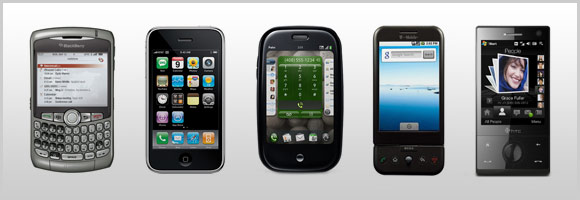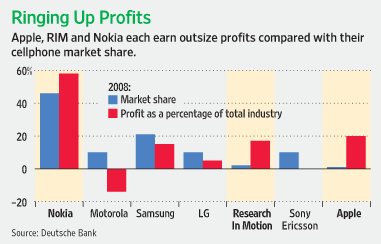
It’s easy to forget that just 20 years ago, mobile phones were a rarity (and the size of a brick). These days we all take them completely for granted and everybody has one.
All these years, mobile makers have competed with each other mainly by trying to outdesign and outfeature each other on the hardware end. Hardware, hardware, hardware. It’s always been the focus. Making the phones smaller, putting cameras in them, making the screens better, and so on. Tech specs were the way to stand out.
Shifting the focus to software
Something very interesting has been happening the last few years, something that culminated with the iPhone. Suddenly it’s not all about hardware anymore. Suddenly software REALLY matters.
Software has of course always been a part of the mobile experience, but it’s only recently that it’s started to take the front seat. This is arguably the reason why the iPhone has been such a huge success so far. It has provided a great platform that not only makes it easy to develop attractive applications for it, but also an easy way for users to gain access to that software. Customization is done in the software layer instead of the hardware layer. Each user can outfit his or her phone with the software they like.
The hardware still matters, but it is there to enable the software, enable the platform. This is the paradigm shift that we’re right in the middle of, with Apple’s iPhone and RIM’s Blackberry showing the way.
Think “platform”
Of course hardware needs to keep improving and be attractive, but mobile phones have to focus ever more on becoming platforms. When this happens the software running on the platform becomes a huge differentiator (including the OS and its interface).
If mobile makers are to fully embrace this platform thinking they need to:
- Have phones with a consistent interface and feature set so that developers have something to aim at.
- Provide good developer tools.
- Provide an easy way for users to find, download (and buy) applications.
Now combine this with an attractive, reasonably affordable hardware and you have a solid platform.
Some are of the opinion that these new smartphones constitute an entirely new category, calling them “superphones.” Here’s an explanation of what a superphone is, from GigaOM:
If a large display and a robust web browser do not a superphone make, then exactly what is it that defines this new category? The operative word is platform. The creative potential of this next generation of hardware is defined by the ecosystem that each respective Superphone vendor’s platform will enable. When features like touchscreens, browsers, location-sensing technologies and hardware acceleration are programmatically exposed through elegant developer tools, a device is two-thirds of the way to superphonedom. Lastly, add an end-to-end international storefront, and a new medium is born.
There’s also another reason that this platform approach is the future: Not only is this good for users, it’s a great way for the mobile makers to make money.
How mobile makers benefit too
By not spreading themselves to thin, with dozens of different phones and all the overhead that that entails, mobile makers can focus their efforts and reduce costs. In spite of having relatively small market shares, Apple and RIM are showing much higher profit margins than traditional mobile makers like Nokia and Sony Ericsson.
In fact, according to a recent report, RIM and Apple accounted for just 3% of all sold cell phones in 2008 but their operating profits accounted for 35% of the entire industry. The report also predicts that this year their market share will rise to 5% in terms of sold units and operating profits will be 58% of the total industry profits. In short, relative to their market share, both RIM and Apple are killing the competition when it comes to profits.

So Apple and RIM have shown the viability of this approach and the very high profit margins that come with it. The challenge for newcomers (such as the Palm Pre, for example) will be to sell enough units to make their platforms attractive to third-party developers, but once that hump has been cleared the possibilities are wide open.
Here are some of the most significant benefits the platform approach gives mobile makers:
- They can market ONE thing: their platform (instead of a bunch of phones). We illustrated this a couple of weeks ago.
- It allows them to focus their research and development both in hardware and software on one platform.
- By enabling third-party developers, these add value to the platform without the mobile maker having to spend a dollar.
Even the tech spec-obsessed Japanese with their hyper-advanced mobile phones are starting to eye this new trend of placing a larger emphasis on software. Here’s a short excerpt from an interesting NY Times article about the Japanese mobile industry:
Japanese developers are jealous of the runaway global popularity of the Apple iPhone and App Store, which have pushed the American and European cellphone industry away from its obsession with hardware specifications to software. “This is the kind of phone I wanted to make,” Mr. Natsuno [developer of NTT DoCoMo’s wireless service] said, playing with his own iPhone 3G”.
The Japanese have long led the way when it comes to mobile phones and their features, so if even they are eyeing the approach taken by the iPhone, you can be sure that big changes are afoot.
The way forward
There is still a pretty strong focus on hardware when you hear how people discuss mobile phones, but the emphasis will be shifting more and more to software. If we’re wrong about this, come back in five years and prove it and we promise to eat our hats. The future holds competing platforms, and ultimately (but don’t hold your breath waiting for it) maybe even a unified mobile platform.
So, agree, disagree? Where do YOU think things are heading?



























